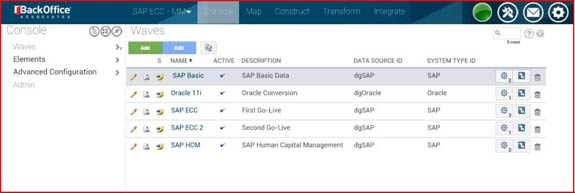Review: Data Stewardship Platform Eases ERP Migration
With over 17 years of data migration experience and half of their customer base coming from the Fortune 500, BackOffice Associates is no newcomer to the world of Big Data. The company provides data migration and consolidation services for moving legacy data into ERP systems from the likes of SAP, Oracle and PeopleSoft.
It has invested many hours and much accumulated wisdom into building its Data Stewardship Platform, a solution that combines field-tested methodology and technology into on-premise and cloud-based solutions.
The BackOffice DSP is a unified and comprehensive platform designed specifically to reduce time, effort and complexity for ERP customers as they address data quality issues in master or business application data. Engineered from the ground up, the DSP accelerates time-to-value in data management initiatives and reduces complexity for data stewards and managers through a guided application experience.
Easing ERP Migrations
A typical ERP migration can involve tens of millions of records, and BackOffice Associates promises it will usually do this with 99.996 percent accuracy. For example, the company told me about a client that used to take roughly a month to get new product and materials information into its ERP system. This meant the information upon which they based decisions was always at least 30 days out of date. BackOffice Associates cut this process down to four days and helped the company make more timely decisions.

A major element of the BackOffice Associates platform is something the company refers to as “data quality as a service.” This starts by understanding the value of information to the business. Then policies are built to align this value with business objectives and business owners to form a governance framework for the data. Business stakeholders take responsibility for their data and make policy-driven decisions around maintaining its integrity.
How Data Stewardship Platform Works
Does the above sound complex? It isn't.
During my time with BackOffice Associates I could see that every effort was made to streamline and simplify the process of data governance. The Data Stewardship Platform is managed by an uncluttered Web-based tool that is compatible with all major browsers. As mentioned previously, data governance policy and methodology is embedded into the product. For the data steward, the business user responsible for the data, all that's left to do is to use the GUI to verify that data conforms to policy.
Data is organized into Content Scopes. A Scope is sort of like all of the data in a particular system. Within Content Scopes are Waves, or projects based on data source and system type. Work done on Waves is forced to adhere to an agile and repeatable process. Waves allow business users and system integrators to work together using real data and real data governance policy.
The beauty of the GUI lies in its minimalism. Users are shown only what they need at a given moment to accomplish the task at hand. This reduces the confusion that might accompany managing a massive data set, eliminates operations that could corrupt the data set, and provides a streamlined way for a data steward to work with the data.
A large part of the Data Stewardship Platform's functionality comes from an area called “Construct” where data can be built or transformed to adhere to the new system's rules. A legacy system may store a piece of information differently than the new ERP system. The legacy system might save floor and room number in two separate fields, for example, while the ERP system saves the information in one field.
Construct maps the old values to the new values based on established rules. No one has to create fields, add columns or write code. Construct uses built-in logic and validations to keep the migration running smoothly. The goal is to start with clean data and keep it clean.
When a data cleanliness issue arises, the Data Stewardship Platform's monitor (dspMonitor) alerts stakeholders to potential data quality issues. dspMonitor also emails alerts to business users so they can go into the system and proactively resolve potential data quality issues. dspMonitor can be configured to escalate alerts as well, so no data governance issues fall through the cracks. DSP comes with over 600 built-in reports, and it is easy to develop new custom reports.
The BackOffice Data Stewardship Platform governs data at every step of the migration process. Policy and rules establish the validity of the data, while automated alerts inform the business user of potential issues with his data and pull his responses directly into the migration workflow. All of this combines to make sure that a new ERP system goes live with high quality data.
Matthew David Sarrel is executive director of Sarrel Group, an editorial services, product test lab and information technology consulting company. He is a contributing editor for PC Magazine, a contributing analyst for GigaOM and a frequent contributor to the Internet.com family of sites. Previously he was a technical director for PC Magazine Labs, where he led all testing conducted by the Applications, Enterprise and Development Software, OS and Utilities, Network Infrastructure and Wireless LAN teams. His career also includes stints as an executive at two Internet startups and as director of IT for the New Jersey Medical School National Tuberculosis Center.